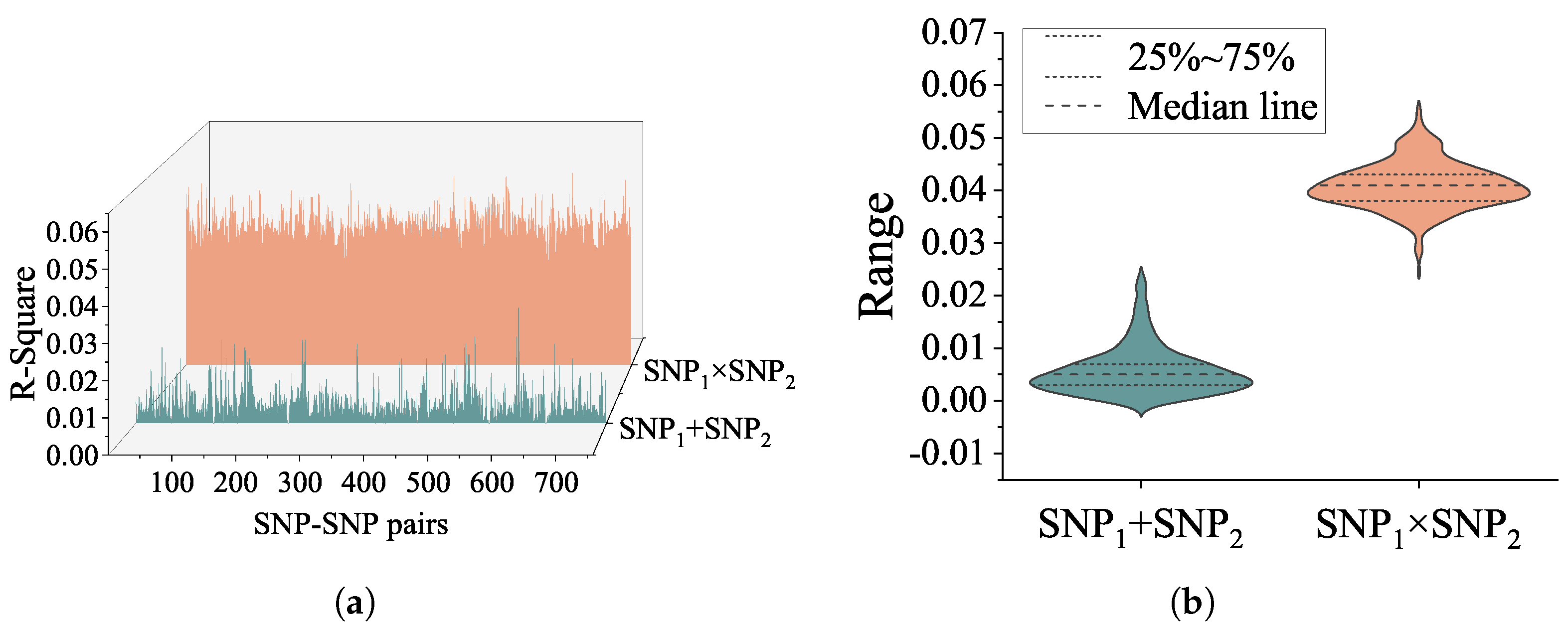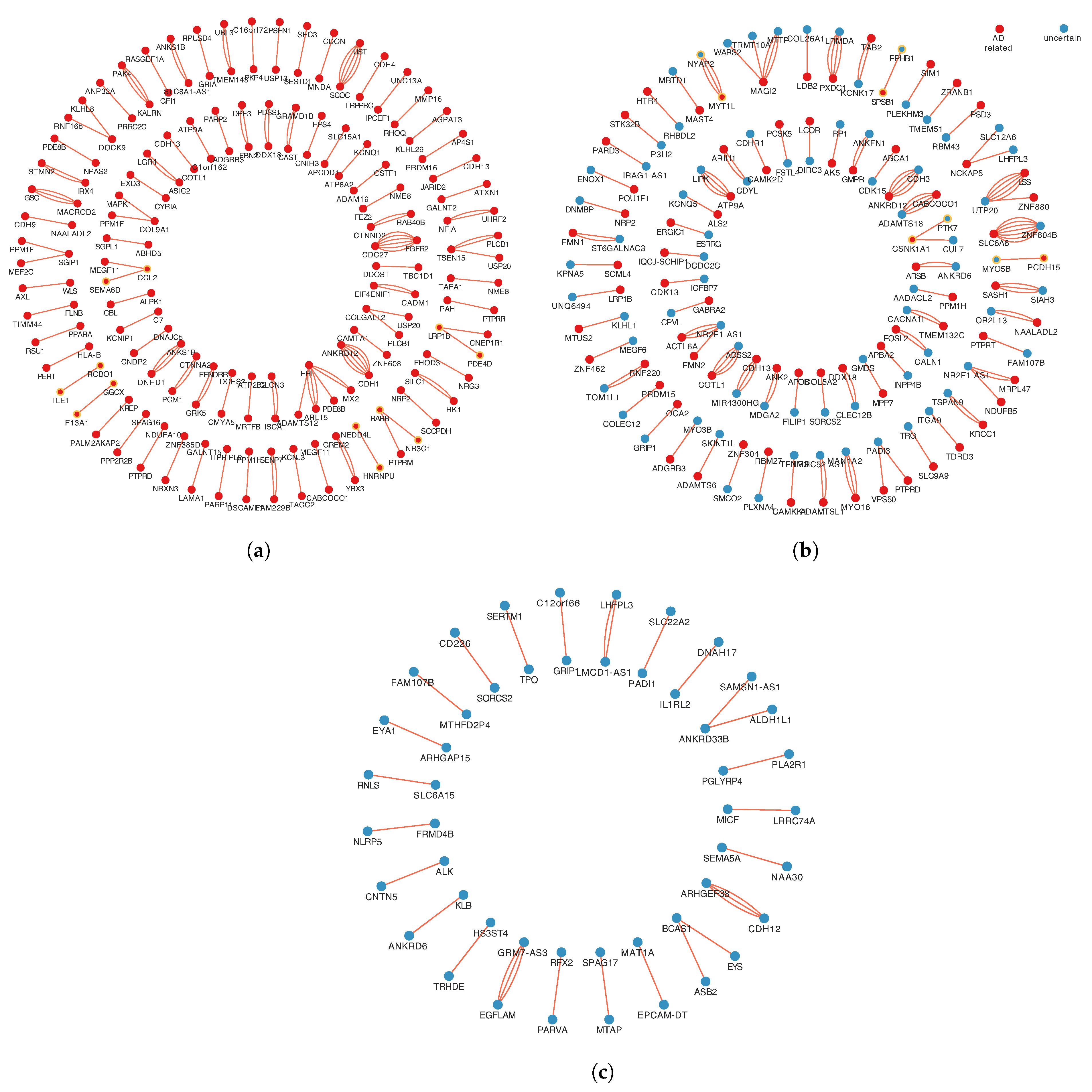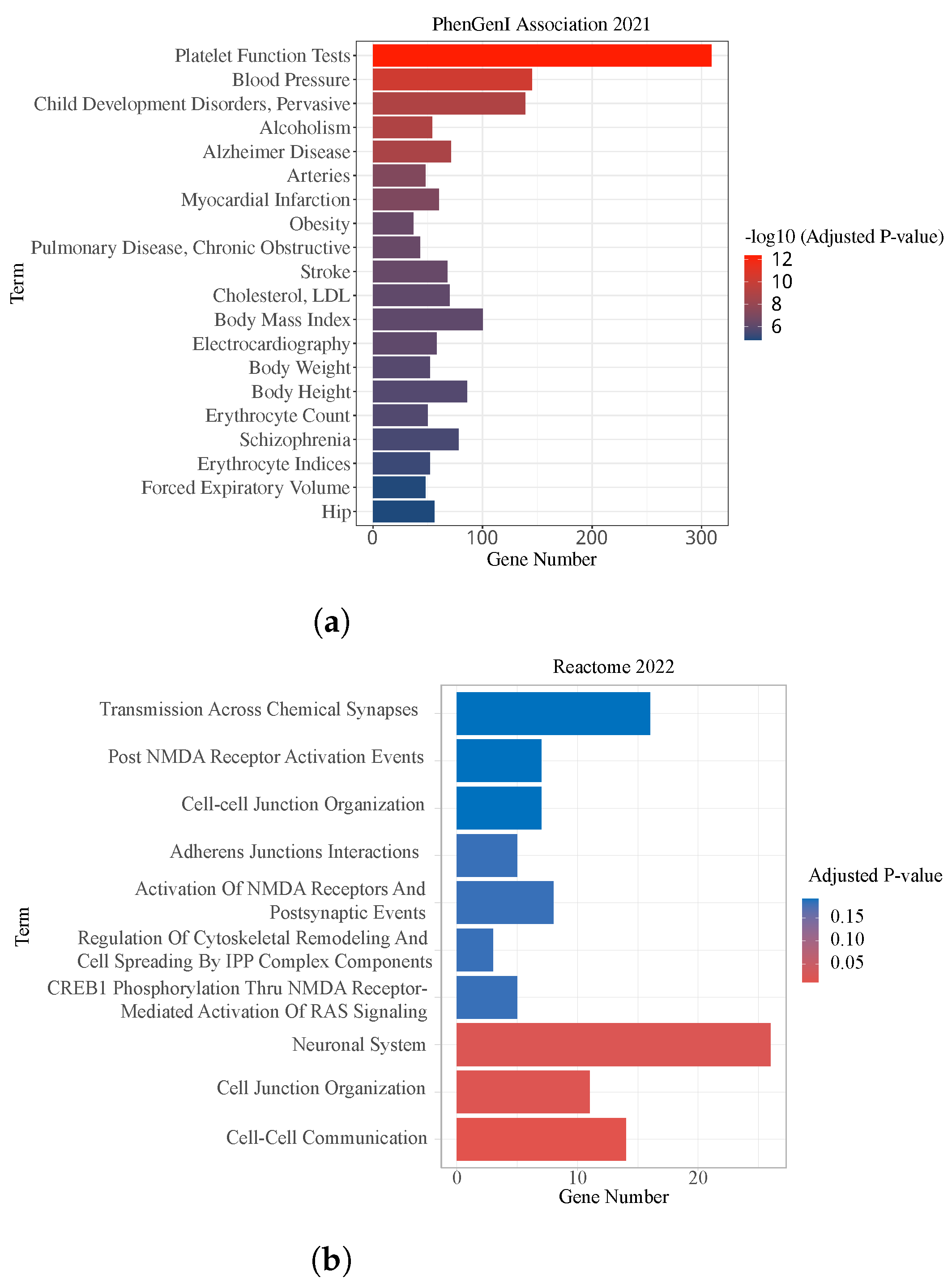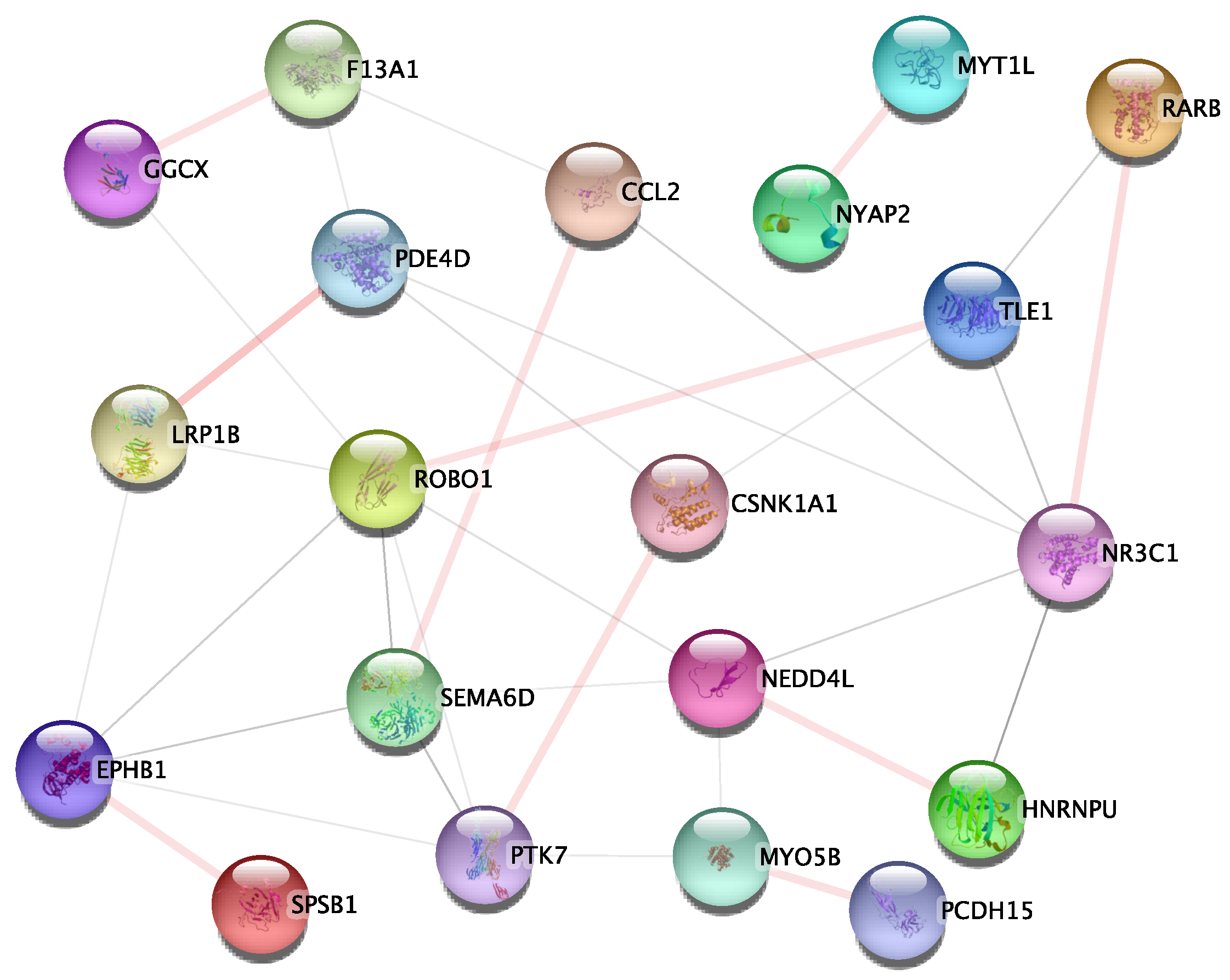Genome-Wide Epistasis Study of Cerebrospinal Fluid Hyperphosphorylated Tau in ADNI Cohort
Abstract
:1. Introduction
2. Materials and Methods
2.1. Genotyping Data and Subjects Processing
2.2. Genome-Wide SNP-SNP Interaction Analysis
2.3. Bioinformatics Analyses
3. Results
3.1. SNP-SNP Interaction Results
3.2. Functional Annotations for Significant Interaction Pairs
3.3. Potential Interactions via Protein-Protein Interaction Analysis
4. Discussion
5. Conclusions
Author Contributions
Funding
Institutional Review Board Statement
Informed Consent Statement
Data Availability Statement
Acknowledgments
Conflicts of Interest
References
- Zhang, C.; Griciuc, A.; Hudry, E.; Wan, Y.; Quinti, L.; Ward, J.; Forte, A.M.; Shen, X.; Ran, C.; Elmaleh, D.R.; et al. Cromolyn reduces levels of the Alzheimer’s disease-associated amyloid β-protein by promoting microglial phagocytosis. Sci. Rep. 2018, 8, 1144. [Google Scholar] [CrossRef] [Green Version]
- Rusek, M.; Smith, J.; El-Khatib, K.; Aikins, K.; Czuczwar, S.J.; Pluta, R. The Role of the JAK/STAT Signaling Pathway in the Pathogenesis of Alzheimer’s Disease: New Potential Treatment Target. Int. J. Mol. Sci. 2023, 24, 864. [Google Scholar] [CrossRef] [PubMed]
- Bloom, J.S.; Ehrenreich, I.M.; Loo, W.T.; Lite, T.L.V.; Kruglyak, L. Finding the sources of missing heritability in a yeast cross. Nature 2013, 494, 234–237. [Google Scholar] [CrossRef] [Green Version]
- Jansen, I.E.; Savage, J.E.; Watanabe, K.; Bryois, J.; Williams, D.M.; Steinberg, S.; Sealock, J.; Karlsson, I.K.; Hägg, S.; Athanasiu, L.; et al. Genome-wide meta-analysis identifies new loci and functional pathways influencing Alzheimer’s disease risk. Nat. Genet. 2019, 51, 404–413. [Google Scholar] [CrossRef] [PubMed] [Green Version]
- Simmonds, E.; Leonenko, G.; Schmidt, K.M.; Hill, M.; Myers, A.; Shoai, M.; de Rojas, I.; Tesi, N.; Holstege, H.; van der Flier, W.; et al. What does heritability of Alzheimer’s disease represent? PLoS ONE 2023, 18, e0281440. [Google Scholar]
- Andrews, S.J.; Renton, A.E.; Fulton-Howard, B.; Podlesny-Drabiniok, A.; Marcora, E.; Goate, A.M. The complex genetic architecture of Alzheimer’s disease: Novel insights and future directions. eBiomedicine 2023, 90, 104511. [Google Scholar] [CrossRef] [PubMed]
- Ebbert, M.T.; Ridge, P.G.; Kauwe, J.S. Bridging the gap between statistical and biological epistasis in Alzheimer’s disease. BioMed Res. Int. 2015, 2015, 870123. [Google Scholar] [CrossRef]
- Min, A.; Thompson, E.; Basu, S. Comparing heritability estimators under alternative structures of linkage disequilibrium. G3 2022, 12, jkac134. [Google Scholar] [CrossRef]
- KaradaĞ, Ö.; Altun, G.; AktaŞ, S. Assessment of SNP-SNP interactions by using square contingency table analysis. An. Acad. Bras. CiÊNcias 2020, 92. [Google Scholar] [CrossRef]
- Lutz, M.W.; Sprague, D.; Chiba-Falek, O. Bioinformatics strategy to advance the interpretation of Alzheimer’s disease GWAS discoveries: The roads from association to causation. Alzheimer’s Dement. 2019, 15, 1048–1058. [Google Scholar] [CrossRef]
- Goudey, B.; Rawlinson, D.; Wang, Q.; Shi, F.; Ferra, H.; Campbell, R.M.; Stern, L.; Inouye, M.T.; Ong, C.S.; Kowalczyk, A. GWIS-model-free, fast and exhaustive search for epistatic interactions in case-control GWAS. BMC Genom. 2013, 14, S10. [Google Scholar] [CrossRef] [PubMed] [Green Version]
- Mackay, T.F.; Moore, J.H. Why epistasis is important for tackling complex human disease genetics. Genome Med. 2014, 6, 42. [Google Scholar] [CrossRef] [Green Version]
- Mackay, T.F. Epistasis and quantitative traits: Using model organisms to study gene–gene interactions. Nat. Rev. Genet. 2014, 15, 22–33. [Google Scholar] [CrossRef] [Green Version]
- Moore, J.H. A global view of epistasis. Nat. Genet. 2005, 37, 13–14. [Google Scholar] [CrossRef]
- Chang, Y.C.; Wu, J.T.; Hong, M.Y.; Tung, Y.A.; Hsieh, P.H.; Yee, S.W.; Giacomini, K.M.; Oyang, Y.J.; Chen, C.Y. GenEpi: Gene-based epistasis discovery using machine learning. BMC Bioinform. 2020, 21, 68. [Google Scholar] [CrossRef]
- Yang, Y.; Yao, S.; Ding, J.M.; Chen, W.; Guo, Y. Enhancer-gene interaction analyses identified the epidermal growth factor receptor as a susceptibility gene for type 2 diabetes mellitus. Diabetes Metab. J. 2021, 45, 241–250. [Google Scholar] [CrossRef] [PubMed]
- Cordell, H.J. Detecting gene–gene interactions that underlie human diseases. Nat. Rev. Genet. 2009, 10, 392–404. [Google Scholar] [CrossRef] [PubMed] [Green Version]
- Wang, H.; Yue, T.; Yang, J.; Wu, W.; Xing, E.P. Deep mixed model for marginal epistasis detection and population stratification correction in genome-wide association studies. BMC Bioinform. 2019, 20, 656. [Google Scholar] [CrossRef] [PubMed]
- Russ, D.; Williams, J.A.; Cardoso, V.R.; Bravo-Merodio, L.; Pendleton, S.C.; Aziz, F.; Acharjee, A.; Gkoutos, G.V. Evaluating the detection ability of a range of epistasis detection methods on simulated data for pure and impure epistatic models. PLoS ONE 2022, 17, e0263390. [Google Scholar] [CrossRef] [PubMed]
- Wang, Q.; Zhang, Q.; Meng, F.; Li, B. Objective-hierarchy based large-scale evolutionary algorithm for improving joint sparsity-compression of neural network. Inf. Sci. 2023, 640, 119095. [Google Scholar] [CrossRef]
- Yoshida, M.; Koike, A. SNPInterForest: A new method for detecting epistatic interactions. BMC Bioinform. 2011, 12, 469. [Google Scholar] [CrossRef] [PubMed] [Green Version]
- Wang, H.; Nie, F.; Huang, H.; Kim, S.; Nho, K.; Risacher, S.L.; Saykin, A.J.; Shen, L.; Initiative, A.D.N. Identifying quantitative trait loci via group-sparse multitask regression and feature selection: An imaging genetics study of the ADNI cohort. Bioinformatics 2012, 28, 229–237. [Google Scholar] [CrossRef] [PubMed] [Green Version]
- Leng, F.; Edison, P. Neuroinflammation and microglial activation in Alzheimer disease: Where do we go from here? Nat. Rev. Neurol. 2021, 17, 157–172. [Google Scholar] [CrossRef] [PubMed]
- Cruchaga, C.; Kauwe, J.S.; Harari, O.; Jin, S.C.; Cai, Y.; Karch, C.M.; Benitez, B.A.; Jeng, A.T.; Skorupa, T.; Carrell, D.; et al. GWAS of cerebrospinal fluid tau levels identifies risk variants for Alzheimer’s disease. Neuron 2013, 78, 256–268. [Google Scholar] [CrossRef] [Green Version]
- Guo, T.; Korman, D.; La Joie, R.; Shaw, L.M.; Trojanowski, J.Q.; Jagust, W.J.; Landau, S.M. Normalization of CSF pTau measurement by Aβ40 improves its performance as a biomarker of Alzheimer’s disease. Alzheimer’s Res. Ther. 2020, 12, 97. [Google Scholar] [CrossRef]
- Kempuraj, D.; Thangavel, R.; Natteru, P.; Selvakumar, G.; Saeed, D.; Zahoor, H.; Zaheer, S.; Iyer, S.; Zaheer, A. Neuroinflammation induces neurodegeneration. J. Neurol. Neurosurg. Spine 2016, 1, 1003. [Google Scholar]
- Dong, Y.; Yu, H.; Li, X.; Bian, K.; Zheng, Y.; Dai, M.; Feng, X.; Sun, Y.; He, Y.; Yu, B.; et al. Hyperphosphorylated tau mediates neuronal death by inducing necroptosis and inflammation in Alzheimer’s disease. J. Neuroinflamm. 2022, 19, 205. [Google Scholar] [CrossRef]
- Parhizkar, S.; Holtzman, D.M. APOE Mediated Neuroinflammation and Neurodegeneration in Alzheimer’s Disease. In Seminars in Immunology; Elsevier: Amsterdam, The Netherlands, 2022; p. 101594. [Google Scholar]
- Servaes, S.; Lussier, F.Z.; Therriault, J.; Tissot, C.; Bezgin, G.; Kang, M.S.; Wang, Y.T.; Stevenson, J.; Rahmouni, N.; Arias, J.F.; et al. pTau heterogeneity as a measure for disease severity in incipient Alzheimer’s disease. Alzheimer’s Dement. 2022, 18, e063749. [Google Scholar] [CrossRef]
- Penke, B.; Szűcs, M.; Bogár, F. New Pathways Identify Novel Drug Targets for the Prevention and Treatment of Alzheimer’s Disease. Int. J. Mol. Sci. 2023, 24, 5383. [Google Scholar] [CrossRef]
- Arnsten, A.F.; Datta, D.; Del Tredici, K.; Braak, H. Hypothesis: Tau pathology is an initiating factor in sporadic Alzheimer’s disease. Alzheimer’s Dement. 2021, 17, 115–124. [Google Scholar] [CrossRef]
- Meredith, J.E., Jr.; Sankaranarayanan, S.; Guss, V.; Lanzetti, A.J.; Berisha, F.; Neely, R.J.; Slemmon, J.R.; Portelius, E.; Zetterberg, H.; Blennow, K.; et al. Characterization of novel CSF Tau and ptau biomarkers for Alzheimer’s disease. PLoS ONE 2013, 8, e76523. [Google Scholar] [CrossRef] [PubMed]
- Price, A.L.; Patterson, N.J.; Plenge, R.M.; Weinblatt, M.E.; Shadick, N.A.; Reich, D. Principal components analysis corrects for stratification in genome-wide association studies. Nat. Genet. 2006, 38, 904–909. [Google Scholar] [CrossRef] [PubMed]
- Zhang, Q.; Liu, H.; Ao, L.; Liang, H.; Chen, D. A GPU-based approach for detecting genome-wide SNP-SNP interactions of quantitative trait in ADNI cohorts. In Proceedings of the 2022 IEEE International Conference on Bioinformatics and Biomedicine (BIBM), Las Vegas, NV, USA, 6–8 December 2022; pp. 2564–2570. [Google Scholar]
- Cheng, Y.; Pereira, M.; Raukar, N.; Reagan, J.L.; Queseneberry, M.; Goldberg, L.; Borgovan, T.; LaFrance Jr, W.C.; Dooner, M.; Deregibus, M.; et al. Potential biomarkers to detect traumatic brain injury by the profiling of salivary extracellular vesicles. J. Cell. Physiol. 2019, 234, 14377–14388. [Google Scholar] [CrossRef] [PubMed] [Green Version]
- Berger, H.; Wodarz, A.; Borchers, A. PTK7 faces the Wnt in development and disease. Front. Cell Dev. Biol. 2017, 5, 31. [Google Scholar] [CrossRef] [PubMed] [Green Version]
- Palomer, E.; Buechler, J.; Salinas, P.C. Wnt signaling deregulation in the aging and Alzheimer’s brain. Front. Cell. Neurosci. 2019, 13, 227. [Google Scholar] [CrossRef] [Green Version]
- Lee, E.; Giovanello, K.S.; Saykin, A.J.; Xie, F.; Kong, D.; Wang, Y.; Yang, L.; Ibrahim, J.G.; Doraiswamy, P.M.; Zhu, H.; et al. Single-nucleotide polymorphisms are associated with cognitive decline at Alzheimer’s disease conversion within mild cognitive impairment patients. Alzheimer’s Dementia Diagn. Assess. Dis. Monit. 2017, 8, 86–95. [Google Scholar] [CrossRef] [Green Version]
- Tyzack, G.E.; Hall, C.E.; Sibley, C.R.; Cymes, T.; Forostyak, S.; Carlino, G.; Meyer, I.F.; Schiavo, G.; Zhang, S.C.; Gibbons, G.M.; et al. A neuroprotective astrocyte state is induced by neuronal signal EphB1 but fails in ALS models. Nat. Commun. 2017, 8, 1164. [Google Scholar] [CrossRef] [Green Version]
- Conductier, G.; Blondeau, N.; Guyon, A.; Nahon, J.L.; Rovère, C. The role of monocyte chemoattractant protein MCP1/CCL2 in neuroinflammatory diseases. J. Neuroimmunol. 2010, 224, 93–100. [Google Scholar] [CrossRef]
- Cherry, J.D.; Meng, G.; Daley, S.; Xia, W.; Svirsky, S.; Alvarez, V.E.; Nicks, R.; Pothast, M.; Kelley, H.; Huber, B.; et al. CCL2 is associated with microglia and macrophage recruitment in chronic traumatic encephalopathy. J. Neuroinflamm. 2020, 17, 370. [Google Scholar] [CrossRef]
- Finan, G.M.; Kwak, C.; Hyun-Woo, R.; Kim, T.W. Sema6D Promotes TREM2-dependent Phagocytosis in Human iPSC-derived Microglia. Alzheimer’s Dement. 2022, 18, e062563. [Google Scholar] [CrossRef]
- Albanus, R.D.; Finan, G.M.; Brase, L.; Chen, S.; Guo, Q.; Kannan, A.; Acquarone, M.; You, S.F.; Novotny, B.C.; Ribeiro Pereira, P.M.; et al. Systematic characterization of brain cellular crosstalk reveals a novel role for SEMA6D in TREM2-associated microglial function in Alzheimer’s disease. bioRxiv 2022. [Google Scholar] [CrossRef]
- Podleśny-Drabiniok, A.; Marcora, E.; Goate, A.M. Microglial phagocytosis: A disease-associated process emerging from Alzheimer’s disease genetics. Trends Neurosci. 2020, 43, 965–979. [Google Scholar] [CrossRef] [PubMed]
- Wang, K.; Li, J.; Zhang, Y.; Huang, Y.; Chen, D.; Shi, Z.; Smith, A.D.; Li, W.; Gao, Y. Central nervous system diseases related to pathological microglial phagocytosis. Cns Neurosci. Ther. 2021, 27, 528–539. [Google Scholar] [CrossRef] [PubMed]
- Noda, M.; Suzumura, A. Sweepers in the CNS: Microglial migration and phagocytosis in the Alzheimer disease pathogenesis. Int. J. Alzheimer’S Dis. 2012, 2012, 891087. [Google Scholar] [CrossRef] [PubMed] [Green Version]
- Yokoyama, K.; Tezuka, T.; Kotani, M.; Nakazawa, T.; Hoshina, N.; Shimoda, Y.; Kakuta, S.; Sudo, K.; Watanabe, K.; Iwakura, Y.; et al. NYAP: A phosphoprotein family that links PI3K to WAVE1 signalling in neurons. Embo J. 2011, 30, 4739–4754. [Google Scholar] [CrossRef] [Green Version]
- Pelucchi, S.; Stringhi, R.; Marcello, E. Dendritic spines in Alzheimer’s disease: How the actin cytoskeleton contributes to synaptic failure. Int. J. Mol. Sci. 2020, 21, 908. [Google Scholar] [CrossRef] [Green Version]
- Tiwari, N.K.; Sathyanesan, M.; Schweinle, W.; Newton, S.S. Carbamoylated erythropoietin induces a neurotrophic gene profile in neuronal cells. Prog. NeuroPsychopharmacol. Biol. Psychiatry 2019, 88, 132–141. [Google Scholar] [CrossRef]
- Hettige, N.C.; Ernst, C. FOXG1 dose in brain development. Front. Pediatr. 2019, 7, 482. [Google Scholar] [CrossRef] [Green Version]
- Chen, Y.; Tian, L.; Zhang, F.; Liu, C.; Lu, T.; Ruan, Y.; Wang, L.; Yan, H.; Yan, J.; Liu, Q.; et al. Myosin Vb gene is associated with schizophrenia in Chinese Han population. Psychiatry Res. 2013, 207, 13–18. [Google Scholar] [CrossRef]
- Murphy, C.E.; Walker, A.K.; Weickert, C.S. Neuroinflammation in schizophrenia: The role of nuclear factor kappa B. Transl. Psychiatry 2021, 11, 528. [Google Scholar] [CrossRef]
- Merluzzi, A.P.; Vogt, N.M.; Norton, D.; Jonaitis, E.; Clark, L.R.; Carlsson, C.M.; Johnson, S.C.; Asthana, S.; Blennow, K.; Zetterberg, H.; et al. Differential effects of neurodegeneration biomarkers on subclinical cognitive decline. Alzheimer’s Dementia Transl. Res. Clin. Interv. 2019, 5, 129–138. [Google Scholar] [CrossRef] [PubMed]
- Rodriguez-Vieitez, E.; Montal, V.; Sepulcre, J.; Lois, C.; Hanseeuw, B.; Vilaplana, E.; Schultz, A.P.; Properzi, M.J.; Scott, M.R.; Amariglio, R.; et al. Association of cortical microstructure with amyloid-β and tau: Impact on cognitive decline, neurodegeneration, and clinical progression in older adults. Mol. Psychiatry 2021, 26, 7813–7822. [Google Scholar] [CrossRef] [PubMed]
- Selkoe, D.J.; Hardy, J. The amyloid hypothesis of Alzheimer’s disease at 25 years. EMBO Mol. Med. 2016, 8, 595–608. [Google Scholar] [CrossRef] [PubMed]





| NO | SNP SNP | GENE | CHR | p-Value | Explained Variance (R Square) | |||
|---|---|---|---|---|---|---|---|---|
| GWAS | Interaction | Age + Gender + cdsr | SNP + SNP | SNP × SNP | ||||
| 1 | rs2291948 | APOOP5 | 16 | 0.963536 | 1.70 × 10 | 0.093 | 0.001 | 0.056 |
| rs2619171 | - | 15 | 0.911948 | |||||
| 2 | rs17069204 | SEC63 | 6 | 0.0222884 | 6.73 × 10 | 0.093 | 0.008 | 0.055 |
| rs4983187 | LINC02588 | 14 | 0.592583 | |||||
| 3 | rs6882813 | - | 5 | 0.420613 | 2.86 × 10 | 0.093 | 0.007 | 0.055 |
| rs17416058 | - | 11 | 0.212032 | |||||
| 4 | rs129600 | PPARA | 22 | 0.635138 | 4.92 × 10 | 0.093 | 0.005 | 0.054 |
| rs6602151 | RSU1 | 10 | 0.870792 | |||||
| 5 | rs6796502 | PRSS42P | 3 | 0.676528 | 4.80 × 10 | 0.093 | 0.004 | 0.053 |
| rs6999890 | SLC45A4 | 8 | 0.454329 | |||||
| 6 | rs1412839 | PDPN | 1 | 0.251693 | 6.00 × 10 | 0.093 | 0.005 | 0.053 |
| rs2397718 | - | 5 | 0.785923 | |||||
| 7 | rs2219872 | GRIP1 | 12 | 0.016483 | 3.52 × 10 | 0.093 | 0.013 | 0.052 |
| rs2647911 | C12orf66 | 12 | 0.292968 | |||||
| 8 | rs9320250 | OSTM1 | 6 | 0.0269661 | 4.37 × 10 | 0.093 | 0.011 | 0.052 |
| rs4983187 | LINC02588 | 14 | 0.592583 | |||||
| 9 | rs10802434 | SCCPDH | 1 | 0.873933 | 8.49 × 10 | 0.093 | 0.006 | 0.052 |
| rs12470444 | NRP2 | 2 | 0.291239 | |||||
| 10 | rs2487643 | PDPN | 1 | 0.231468 | 1.31 × 10 | 0.093 | 0.006 | 0.052 |
| rs2397718 | - | 5 | 0.785923 | |||||
Disclaimer/Publisher’s Note: The statements, opinions and data contained in all publications are solely those of the individual author(s) and contributor(s) and not of MDPI and/or the editor(s). MDPI and/or the editor(s) disclaim responsibility for any injury to people or property resulting from any ideas, methods, instructions or products referred to in the content. |
© 2023 by the authors. Licensee MDPI, Basel, Switzerland. This article is an open access article distributed under the terms and conditions of the Creative Commons Attribution (CC BY) license (https://creativecommons.org/licenses/by/4.0/).
Share and Cite
Chen, D.; Li, J.; Liu, H.; Liu, X.; Zhang, C.; Luo, H.; Wei, Y.; Xi, Y.; Liang, H.; Zhang, Q. Genome-Wide Epistasis Study of Cerebrospinal Fluid Hyperphosphorylated Tau in ADNI Cohort. Genes 2023, 14, 1322. https://doi.org/10.3390/genes14071322
Chen D, Li J, Liu H, Liu X, Zhang C, Luo H, Wei Y, Xi Y, Liang H, Zhang Q. Genome-Wide Epistasis Study of Cerebrospinal Fluid Hyperphosphorylated Tau in ADNI Cohort. Genes. 2023; 14(7):1322. https://doi.org/10.3390/genes14071322
Chicago/Turabian StyleChen, Dandan, Jin Li, Hongwei Liu, Xiaolong Liu, Chenghao Zhang, Haoran Luo, Yiming Wei, Yang Xi, Hong Liang, and Qiushi Zhang. 2023. "Genome-Wide Epistasis Study of Cerebrospinal Fluid Hyperphosphorylated Tau in ADNI Cohort" Genes 14, no. 7: 1322. https://doi.org/10.3390/genes14071322





